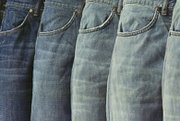Denim Boom Brings Bounty for L.A. Wash Houses
Premium denim is hot, and one of the key reasons for its success can be found in the community of wash and finishing houses in the Los Angeles area.
After struggling with overseas competition, rising energy costs and a variety of other factors over the past few years, the city’s wash houses are finally reaping some fruit. Many are seeing revenue gains well into the double digits.
The West Coast finishing industry has become the destination for innovative denim treatments, including sandblasting, whiskering, baking, stone washing, antiquing and tooling. Even East Coast companies such as James Jeans have settled in the area to take advantage of the skilled dye and wash houses.
“We’re No. 1. The world looks to us for denim,” said Ilse Metchek, executive director of the Los Angeles–based California Fashion Association. “We are defining trends and the newness in finishes. You can design a great pair of jeans, but if you don’t have the right finish, it’s yesterday’s lunch.”
Competition within the local community as well as from Asia and other emerging manufacturing nations is keeping the pressure on industrial laundry owners to continue to come up with new finishes for denim manufacturers. Los Angeles–based A.P.S. Laundry, for example, is embarking on an ambitious process that uses O3, a new proprietary oxygen treatment to create antique finishes on denim without compromising fabrics or stitching as some enzyme and acid washes do. A.P.S. owner Genaro Hernandez is licensing the technology from Commerce, Calif.–based Jantex Inks & Beyond Inc. The process creates a small lightning storm to reduce color saturation and create a weathered effect. The process also uses up to 95 percent less water than standard laundries and is environmentally friendly, according to its inventors.
“You can leave a pair of jeans on a roof for three years or achieve the same finish in minutes using this process,” Hernandez said. “You don’t damage the strength of the fabric, and [you] get a nice vintage finish. It’s all natural.”
Hernandez made the investment because he sees a bright future for the denim industry, which has grown to$11 billion in the United States. It is estimated that about 85 percent of premium denim business is on the West Coast. Hernandez has an 18-month exclusive contract with Jantex for the Los Angeles market.
Jantex said the contract extends to denim only. The technology also works with knit tops and other garments.
“People are looking at it for garment-dyed T-shirts. The process reduces the overall color, and we’ve been working with different chemicals to produce a kind of tie-dye look,” added Jantex’s Opal Mata.
Hernandez’s business reflects the growth of the wash industry. He launched A.P.S. two years ago and expects to complete his second year topping $5 million in revenues. The company’s biggest customer is Guess? Inc., which plans to market the new treatment in a line called L.A.D.A., according to Hernandez. “The market’s only going to get bigger,” he said.
Staying ahead of the competition
While Los Angeles’ wash houses have enjoyed their reputation for cutting-edge washes and finishes, they, like their designer clients, have also had to do battle with overseas competitors that knock off their innovations, noted Ephraim Moosiki of Los Angeles–based Quick Wash Laundry.
“Business is very strong for us right now, but as soon as China finds out about all the new processes, they copy them and then it will slow down again,” Moosiki said. “But we’ll just have to develop even more new washes.”
Quick Wash’s business is up about 50 percent. The company specializes in whiskering, tinting, tooling and grinding and can do potassium, enzyme and stone washes.
California wash houses are keeping an eye on overseas competition. China alone has seen jumps of up to 13 percent in its dye and wash industry, according to the Shanghai International Exhibition Co. Ltd., which each spring puts on the China International Dye Industry, Pigments and Dyeing Auxiliary Exhibition, the world’s largest trade show for garment dyeing and finishing.
Denim designer Mik Serfontaine of Los Angeles–based Serfontaine said the proliferation of denim brands is making it tougher for laundry houses to specialize in one area.“This is a new niche of denim, so it’s a new day for everybody, but we’ve been able to find a wash house that can work with us and create unique finishes based on direction that we give them,”
Serfontaine said. “They only work with us and one other company. There is a small cache of boutique wash houses emerging, and you might see them branding themselves much like they do in Italy, like the Martelli wash house for example.”
Serfontaine’s denim features organic washes, among others, reflecting the company’s pro-environment corporate philosophy. “We never do stone washes. It’s not good for the environment because it’s based on strip-mining of pumice,” said the designer.
Serfontaine fears that knockoffs may hurt business for some, indicating there may be an eventual shakeout. “The high-end market is only as good as the people involved. Knockoff kills innovation, and, in turn, it kills the market,” he said.






















